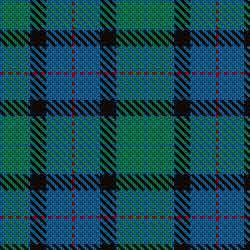|
DESIGN YOUR OWN TARTAN
Choosing the colours, managing their position and creating a tartan before your very eyes is the irrisistible attraction now available online for those seeking their own tartan.
This computer facility, long used in the textile industry, meets a growing demand for new tartans. For weddings, clubs, schools,  corporate application, and those who just simply fancy their own, the personal tartan has seen the number of new tartans registered each year reach around the 150 rank. corporate application, and those who just simply fancy their own, the personal tartan has seen the number of new tartans registered each year reach around the 150 rank.
Scotweb, a company that offers all things Scottish, provides the service on their website. It is based upon the the ten main colour groups recognised by the Scottish Tartans Authority - red, blue, green, yellow, orange, orange, purple, brown, grey, black and white, with some variations - and allows selection of colours and arrangement of check. And instantly shows the result.
Launched last year, appropriately on Saint Andrews Day, Scotweb say "it is a very popular service, particularly with grooms designing kilts for their weddings".
One of Scotweb's Highland outfits, right.
It is not only effective and enjoyable to use, but free. The resulting design may be put to one of a panel of tartan experts, for a fee, for an independent assessment. This is recommended as invaluable to anyone wishing to have their tartan considered for tartan registration.
Once the design is finalised, it may be ordered to be woven in wool, cotton or mixtures. Time for delivery and cost will depend upon the complexity of the design and the choice of fibre, and it may be made up into a kilt. Full details from www.scotweb.co.uk
THOUSANDS OF TARTANS AND ONE FOR EVERYONE
There are thousands of tartans currently on the Scottish Tartans Authority registrar and more are being registered each year. One of them may be yours even if your name is not Scottish and you have no inkling of Scottish roots.
 Most English families can trace a Scot somewhere in their genealogical tree, and a number of very English sounding names can claim use of a tartan. But it doesn't end there. Many foreign names may also reveal some Scottish affiliation, and tracing those Scottish roots is enthusiastically pursued around the globe, especially in North America and the Antipedes. Most English families can trace a Scot somewhere in their genealogical tree, and a number of very English sounding names can claim use of a tartan. But it doesn't end there. Many foreign names may also reveal some Scottish affiliation, and tracing those Scottish roots is enthusiastically pursued around the globe, especially in North America and the Antipedes.
Back in the days of the clan feuds and the Scottish rebellions, many small familes became associated or affiliated with the larger and stronger clans for feudal or "protection" purposes, and among other priviliges this gave them the right to wear the parent clan's tartan.
 For example, affiliated to the great Clan Cameron, and its colourful tartan, are the family names of Clark, Clarke, Kennedy, Paul, Martin, Sorley, Chalmers and many more. For example, affiliated to the great Clan Cameron, and its colourful tartan, are the family names of Clark, Clarke, Kennedy, Paul, Martin, Sorley, Chalmers and many more.
The right to wear the Macmillan tartan is extended to those named Baxter, Bell, and Brown; the Boyds and Carmichaels are associates of the Stewart Clan; and Clan Gordon extends to Beaton, Callum, Lewis, Norman, Nichols and Nicholson, among many others.
If you are a Smith, then you may wear the Dow. Simpson links with Fraser. Taylors are Camerons and Robinsons are affiliated to Clan Gunn. There are literally hundreds of names that may never have been thought of as Scottish yet are entitled to a tartan. Contact the Scottish Tartans Authority and the Scottish Tartan Registrar for more information.
The four tartans shown here may be worn by anyone who does not have a clan affiliation. At top, the Black Watch, above the Flower of Scotland, below the Spirit of Scotland, and at bottom the Jacobite Old Sett. The Black Watch has many variations but this is one of the most popular.
Even if your name  and your family have no Scottish connection, the Scots have kindly come up with some 'general' tartans that may be worn by anyone keen to look the part, four of them shown here. and your family have no Scottish connection, the Scots have kindly come up with some 'general' tartans that may be worn by anyone keen to look the part, four of them shown here.
The number of new tartans added to the official list has been growing. This has caused some controversy within the tartan hierarchy, with some maintaining that the relatively newly appointed Scottish Tartans Authority (just last year), by accepting some of these new designs, is diluting the traditional product. Others believe it illustrates increasing interest that can only be beneficial.
 But whatever the rights and wrongs of the situation, the popularity of having a special tartan designed is irrisistible to many Scottish fans, especially in North America. But whatever the rights and wrongs of the situation, the popularity of having a special tartan designed is irrisistible to many Scottish fans, especially in North America.
Catering for this, Kinloch Anderson and Geoffrey (Tailor) are two companies that provide a professional tartan design service, and list clan tartans.
Delve into any number of websites for further information on tartans and clans but the two authorities are the Scottish Register of Tartans and the Scottish Tartans Authority.
|